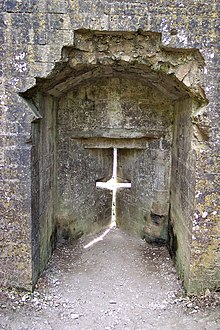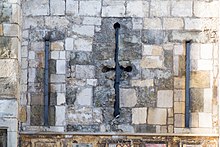Anarrowslit(often also referred to as anarrow loop,loopholeorloop hole,and sometimes abalistraria[1]) is a narrow vertical aperture in afortificationthrough which anarchercan launcharrowsor acrossbowmancan launchbolts.


The interior walls behind an arrow loop are often cut away at anoblique angleso that the archer has a widefield of viewandfield of fire.Arrow slits come in a variety of forms. A common one is thecross,accommodating the use of both thelongbowand thecrossbow.The narrow vertical aperture permits the archer large degrees of freedom to vary theelevationand direction of their bowshot but makes it difficult for attackers to harm the archer since there is only a small target at which to aim.
Balistraria, plural balistrariae, from balister, crossbowman[1][2]can often be found in thecurtain wallsof medievalbattlementsbeneath thecrenellations.
History
editThe invention of the arrowslit is attributed toArchimedesduring thesiege of Syracusein 214–212 BC (although archaeological evidence supports their existence inEgyptian Middle Kingdomfortsaround 1860 BC).[3]Slits "of the height of a man and about a palm's width on the outside" allowed defenders to shoot bows andscorpions(an ancient siege engine) from within thecity walls.[4]Although used in late Greek and Roman defences, arrowslits were not present in early Normancastles.They are reintroduced to military architecture only towards the end of the 12th century, with the castles ofDoverandFramlinghamin England, andRichard the Lionheart'sChâteau Gaillardin France. In these early examples, arrowslits were positioned to protect sections of the castle wall, rather than all sides of the castle. In the 13th century, it became common for arrowslits to be placed all around a castle's defences.[4]
Elements of fortification such as arrowslits became associated with high social standing and authority.[5]As such, damaging them could be significant as an aspect ofslighting.[6]
The successor of arrowslits after the advent ofgunpowderwas theloopholeforfirearms.
Design
editIn its simplest form, an arrowslit was a narrow vertical opening; however, the different weapons used by defenders sometimes dictated the form of arrowslits. For example, openings forlongbowmenwere usually tall and high to allow the user to shoot standing up and make use of the 6 ft (1.8 m) bow, while those for crossbowmen were usually lower down as it was easier for the user to shoot whilst kneeling to support the weight of the weapon. It was common for arrowslits to widen to a triangle at the bottom, called a fishtail, to allow defenders a clearer view of the base of the wall.[7]Immediately behind the slit there was a recess called anembrasure;this allowed a defender to get close to the slit without being too cramped.[8]The width of the slit dictated the field of fire, but the field of vision could be enhanced by the addition of horizontal openings; they allowed defenders to view the target before it entered range.[7]
Usually, the horizontal slits were level, which created a cross shape, but less common was to have the slits off-set (called displaced traverse slots) as demonstrated in the remains ofWhite Castlein Wales. This has been characterised as an advance in design as it provided attackers with a smaller target;[9]however, it has also been suggested that it was to allow the defenders of White Castle to keep attackers in their sights for longer because of the steepmoatsurrounding the castle.
When an embrasure linked to more than one arrowslit (in the case ofDover Castle,defenders from three embrasures can shoot through the same arrowslit) it is called a "multiple arrowslit".[10]Some arrowslits, such as those atCorfe Castle,had lockers nearby to store spare arrows and bolts; these were usually located on the right hand side of the slit for ease of access and to allow a rapid rate of fire.[7]
See also
edit- Loophole (firearm),a protected small opening to discharge a firearm.
- Loophole
References
edit- ^abRev. Thomas Davidson (1903). "Balistraria; Balister".Chambers's Twentieth Century Dictionary.
Balistraria, bal-is-trar'i-a, n. An aperture or loophole in the wall of a fortification through which crossbowmen might discharge their bolts. Balister (pbs.), name for an arbalester or crossbowman, also an arbalest or crossbow itself.
- ^"balistraria".Merriam-Webster.com Dictionary.Merriam-Webster.
- ^"7.10 Egyptian Forts in Nubia and Indigenous Peoples There".worldhistory.biz.8 May 2015.Retrieved23 September2018.
- ^abJones & Renn 1982,p. 445.
- ^Wheatley 2004,p. 2
- ^Liddiard 2005,p. 68
- ^abcFriar 2003,pp. 180–181.
- ^Friar 2003,p. 104
- ^Jones & Renn 1982,p. 451
- ^Friar 2003,p. 182
Bibliography
edit- De Lange, William (2021).An Encyclopedia of Japanese Castles.Toyo Press.ISBN978-9492722300.
- Friar, Stephen (2003),The Sutton Companion to Castles,Stroud: Sutton Publishing,ISBN978-0-7509-3994-2
- Jones, Peter; Renn, Derek (1982), "The military effectiveness of Arrow Loops: Some experiments at White Castle",Château Gaillard: Études de castellologie médiévale,IX–X,Centre de Recherches Archéologiques Médiévales: 445–456
- Liddiard, Robert (2005),Castles in Context: Power, Symbolism and Landscape, 1066 to 1500,Macclesfield: Windgather Press,ISBN9780954557522
- Wheatley, Abigail (2004),The Idea of the Castle in Medieval England,York: York Medieval Press